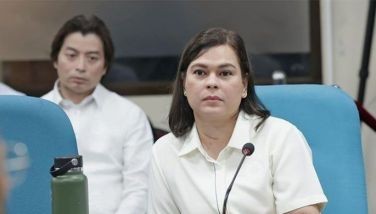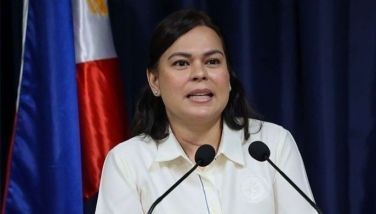Castillo in top form / Salonga amazes again /A note on singer Cosio
January 10, 2007 | 12:00am
 Determined to introduce new works to music lovers and thus widen their musical vocabulary, Philippine Philharmonic Orchestra Conductor Eugene F. Castillo again risked a reduced audience at the CCP main theater last Friday. But he was in his element as he balanced the contemporary Symphony No. 4 by David Diamond with the traditional — Dvorak’s Symphony No. 8 in G Major, playing the composer’s "Ten Biblical Songs" in-between, with baritone Noel Azcona rendering them.
Determined to introduce new works to music lovers and thus widen their musical vocabulary, Philippine Philharmonic Orchestra Conductor Eugene F. Castillo again risked a reduced audience at the CCP main theater last Friday. But he was in his element as he balanced the contemporary Symphony No. 4 by David Diamond with the traditional — Dvorak’s Symphony No. 8 in G Major, playing the composer’s "Ten Biblical Songs" in-between, with baritone Noel Azcona rendering them.
Pacing was brisk and precise in Diamond’s Symphony, the movements clearly defined and differentiated, one from the other, the adagio lyrical, the allegretto and allegro lively and robust.
The solo oboe in the opening allegretto, the violins in the second movement, the brass winds and drums demonstrating "manic exuberance" in the third movement were technically unassailable. They were indeed in the finest form as they acutely responded to the subtle cueing of Conductor Castillo.
The remarkable performance was sustained in the well-loved, highly familiar symphony by Dvorak, the cellos, clarinets, bassoon, horn and solo flute in the opening allegro con brio conveying spirit and fluency. The waltz in the third movement was exquisitely interpreted, reflecting charm, verve and vitality. The orchestra was at expressive in the Biblical songs. So was baritone Azcona, whose dramatization of the text was moving, despite his enunciation which left something to be desired.
In sum, the concert, which left a considerable impact on the audience, deserved the highest praise under Castillo’s baton. A pity attendance was minimal.
By temperament, Oliver tends to be dramatic; he startles listeners with surging chordal thrusts which come suddenly after long, quiet passages, displaying steely fingers for the chords, and nimble ones for the rapid runs and double runs.
Musicologists point to Barber’s sonata as having "harmonic and rhythmic robustness, physical strength combined with a fine-grained lyrical expression". Robustness and physical strength surfaced more than lyricism in Oliver’s interpretation.
The sonata ended with Oliver infusing rousing power into its mighty fugal structure.
The Beethoven sonata was similarly electrifying as the pianist intensified rhythmic drive and precision with dramatic élan.
In Lizst’s sonata, storm and calm continuously alternated, the thunderous chords contrasting with a wide gradation of pianissimos that ended almost, but not quite, inaudibly. The bravura playing was astounding in its virtuosity which seemingly created blizzards at amazing speed, with the great surges of sound subsiding again in an endless cycle. There was a degree of showmanship in Oliver’s manner, and one wondered how Lizst, the great showman himself, would have interpreted his own compositions in those salons overflowing with long-gowned, half-swooning women.
The idee fixé invented by Berlioz and imitated by Lizst kept recurring, the theme being repeated and transformed arrestingly by Oliver again and again until the conclusion of the sonata, while diversifying the theme through touch, dynamics and expression.
It was a tremendous climax to what might be described, on the whole, as an amazing tour de force.
BrandSpace Articles
<
>
- Latest
- Trending
Trending
Latest




























